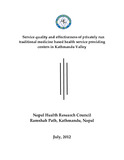Please use this identifier to cite or link to this item:
https://hdl.handle.net/20.500.14356/405| Title: | Service quality and effectiveness of privately run traditional medicine based health service providing centers in Kathmandu Valley |
| Authors: | Nepal Health Research Council (NHRC), Ramshah Path, Kathmandu, Nepal |
| Issue Date: | Jul-2012 |
| Publisher: | Nepal Health Research Council |
| Keywords: | Traditional Medicine Nepal |
| Abstract: | This combine study -Service quality and effectiveness of privately run traditional medicine based health service providing centers in Kathmandu valley – explores the present situation of privately run traditional medicine based health service providing centers in the Kathmandu valley. Fulfillment of the basic requirements specified by the ministry of health and population was considered as the quality of the services and the perception of the services was considered as parameters for the measurement of effectiveness although these two parameters are not enough to assess the quality as well as effectiveness of the services. Data and information were gathered through interview, observation, questionnaires. A format was prepared based on the Guideline-2061prepared by Ministry of Health and Population as a tools to gather information regarding infrastructure, human resources, services, tools and equipments, drugs and other. Different 25 (five from each system- Ayurveda, Naturopathy, Homeopathy, Acupuncture and Amchi) registered hospitals or clinics were selected by simple random method and 132 patients were selected at convenient of the researchers ranging from 5-7 from each of 25 centers. These data and information were gathered between January and February of 2012, however interaction with some of the practitioners was continued until data were analyzed to get personal experience, knowledge and information in particular issues as per need for the research. Traditional medicine based health service centers were found almost never monitored and evaluated once observed by the incumbents of concerned agencies at the time of establishment. This research is, therefore, an important step thatassesses the present situation of health centers and the outcomes could be a strong input for policymakers and planners as well as other researcher to continue similar study in future. Out of total 132 patients interviewed, 59.85% patients’ first visit was the modern hospitals before visiting traditional medicine based health service centers, 64.4% believed modern medicine could not cure their problems, 75% were suggested by relatives and other known persons to visit traditional medicine centers. Likewise, 55.33% believed that their problem had been improving, 43.18% said ‘not yet but hopeful tobe cured soon’, 29% were fully satisfied by the treatment, 53% said ‘treatment is satisfactory’, and 60% said ‘doctors are very good’. Nearly 27 types of diseases or problems were common that people visit all the systems. Hospital level service centers were found only in Ayurveda and Naturopathy. Homeopathy and Unani services were found running by pharmacy and significantly few in numbers in comparison with Ayurveda and Naturopathy. Amchi clinics were found widely practiced by the Tibeto-burman people living in Bauddha and Swoyambhu area and yet to get and not so convenient for the people of other communities due to language restriction. Basic physical infrastructures as specified by the ministry was found almost fulfilled by the most of the health centers but this research could not go through the details of quality and quantity of the available resources. Post-graduate human resources were seldom available in the centers. Even if available, they were providinggeneral services rather specialized service as per their educational background. Referral systems from one to another systems or one to another physicians within the systems was found nominal. Treatments and therapies offered by the centers were almost general services rather specialized in the terms of quality. Except one reported in Ayurveda, almost none of the centers have prepared treatment protocols that guarantee consistency in service and quality. Within the limited resources and without adequate state support, how the traditional medicine based health centers have been providing health services is obviously appreciable. Perception and experiences of both service providers and service users were positive and found satisfied. However, satisfactionalways does not assure service quality and effectiveness. During the study, interviewed physicians agreed that health service centers in traditional medicine are not able to provide quality service that meet global standard because of lack of skilled human resources, quality drugs, modern tools and equipments which are basic necessity of health centers. Most of the centers were found struggling for sustainability since they were not able to provide specialized services. Nation should be clear in recognition of traditional systems of medicine, adopt appropriate model for integration into national health care system, encourage private sector to import quality technology, facilitate private sectors to establish educational, research and development organizations, develop inter-sectoral networks and efficient monitoring and evaluation mechanism. Frequent discussion and interaction withthe practitioners among various systems of traditional medicine is important not only to share knowledge and experience to each other but also develop harmonious relationship among them. At least, if the state focuses on what WHO has recommended to all the member country regarding to promotion and utilization of traditional medicine, all these systems hopefully can have a quantum leap in near future. |
| metadata.dc.description.sponsorship: | Government of Nepal (Ministry of Health and population) |
| URI: | http://103.69.126.140:8080/handle/20.500.14356/405 |
| Appears in Collections: | NHRC Research Report |
Items in DSpace are protected by copyright, with all rights reserved, unless otherwise indicated.

